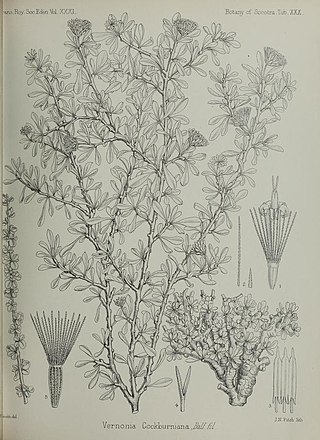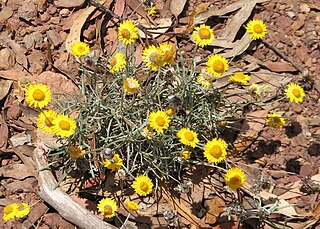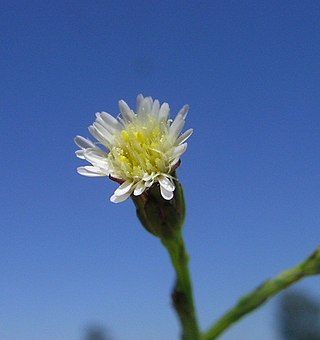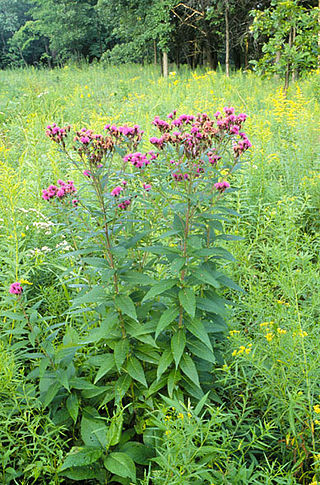
Lodoicea, commonly known as the sea coconut, coco de mer, or double coconut, is a monotypic genus in the palm family. The sole species, Lodoicea maldivica, is endemic to the islands of Praslin and Curieuse in the Seychelles. It has the biggest seed in a plant. It formerly also was found on the small islets of St Pierre, Chauve-Souris, and Ile Ronde, all located near Praslin, but had become extinct there for a time until recently reintroduced.

Vernonia is a genus of about 350 species of forbs and shrubs in the family Asteraceae. Some species are known as ironweed. Some species are edible and of economic value. They are known for having intense purple flowers. There have been numerous distinct subgenera and subsections named in this genus, and some botanists have divided the genus into several distinct genera. For instance, the Flora of North America recognizes only about twenty species in Vernoniasensu stricto, seventeen of which are in North America north of Mexico, with the others being found in South America.

Nepenthes khasiana is an endangered tropical pitcher plant of the genus Nepenthes. It is the only Nepenthes species native to India. It is thought to attract prey by means of blue fluorescence.

Centaurea cineraria, the velvet centaurea, is also known as dusty miller and silver dust. Centaurea cineraria is in the family Asteraceae and is endemic to Italy. In natural settings, it grows on coastal cliffs, ranging from 0–350 m above sea level. Mature plants may reach 80 centimetres (31.5 in) in height. Centaurea cineraria produces purple flowers.

Vernonia cockburniana is a species of flowering plant in the Asteraceae family. It is endemic to Yemen. Its natural habitats are subtropical or tropical dry forests and subtropical or tropical dry shrubland.

Leucochrysum albicans, commonly known as hoary sunray, is a flowering plant in the family Asteraceae. It is a small perennial with grey leaves, white or yellow flower-heads and is endemic to Australia.

Vernonia arkansana is a species of perennial plant from family Asteraceae found in south-central United States. The plant is 4–6 feet (1.2–1.8 m) high and 3–4 feet (0.91–1.22 m) wide. The flowers bloom from August to September and are pink-purple coloured. The cultivar 'Mammuth' is a recipient of the Royal Horticultural Society's Award of Garden Merit.

The flora of Madagascar consists of more than 12,000 species of plants, as well as a poorly known number of fungi and algae. Around 83% of Madagascar's vascular plants are found only on the island. These endemics include five plant families, 85% of the over 900 orchid species, around 200 species of palms, and such emblematic species as the traveller's tree, six species of baobab and the Madagascar periwinkle. The high degree of endemism is due to Madagascar's long isolation following its separation from the African and Indian landmasses in the Mesozoic, 150–160 and 84–91 million years ago, respectively. However, few plant lineages remain from the ancient Gondwanan flora; most extant plant groups immigrated via across-ocean dispersal well after continental break-up.

Vernonia arborea is a species of mid-level rainforest tree in the Composite, or Daisy family Asteraceae that is found in Western Ghats of India and Sri Lanka and is also widespread in the East Indies. This tree, and Brachylaena are contenders for the tallest of all composite trees with the variety V. a. pilifera of Sumatra reaching a height of 117 feet. Another variety, V. a. javanica of Java almost as tall is up to 3 ft 5 in thick, the most massive of all composites. Its leaves contain a useful fungicide.

Symphyotrichum subulatum, commonly known as eastern annual saltmarsh aster or, in Britain and Ireland where it is naturalized, annual saltmarsh aster, is an annual plant in the family Asteraceae native to the eastern United States and the Gulf Coast to Texas. The species grows primarily in coastal salt marshes, although in the Ozarks it occurs as a non-marine weedy variety.

Lecocarpus pinnatifidus, the wing-fruited leocarpus, is a species of flowering plant in the family Asteraceae. It is found in only on the Floreana Island of the Galápagos Islands.

Vernonia baldwinii, commonly known as western ironweed or Baldwin's ironweed, is a perennial herb native to the central United States. It is in the Asteraceae (aster) family.
Vernonia alleizettei is a species of flowering plant in the family Asteraceae. It is endemic to Madagascar.
Vernonia beddomei is a species of perennial plant in the family Asteraceae. It is endemic to India.
Brenandendron is a genus of plants in the family Asteraceae, native to tropical Africa. The genus is named for the British botanist John Patrick Micklethwait Brenan and its species were formerly placed in the genus Vernonia.
Brenandendron frondosum is a plant in the family Asteraceae, native to tropical Africa.

Cabobanthus is a genus of plants in the family Asteraceae, native to tropical Africa. Its species were formerly placed in the genus Vernonia.
Orbivestus is a genus of shrubs in the family Asteraceae, native to tropical Africa, the Arabian Peninsula and the Indian subcontinent. Its species were formerly placed in the genus Vernonia.
Orbivestus homilanthus is a plant in the family Asteraceae.

Vernonia fasciculata, the smooth ironweed or common ironweed, or prairie ironweed is a species of perennial plant in the family Asteraceae. It is native to Manitoba in Canada and the north-central U.S.A.













